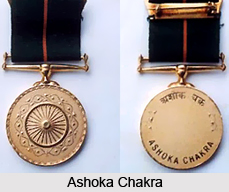 Ashoka Chakra like other gallantry awards shall be awarded for most conspicuous bravery or some act of valour and pre-eminent bravery as well as self sacrifice. As mentioned in the military acts if the recipient of Ashok Chakra happens to repeat his act of bravery for which he has been eligible for the award, then a new bar shall be attached to the riband by which the Chakra is suspended. Every subsequent act of bravery shall bring a new band attached which shall add to the honour of the personal. Like Param Vir Chakra every military official, men and women of Indian Army, Indian Navy and Indian Air Force; of any reserved force, or territorial army, Militia or any other lawfully constituted forces shall be eligible for the award. This award shall grant Rs 1400 to the recipient against each bar in every month. This award is also shared by the non military civilian population who has passed through all the stages of life, by the brave police forces as well as by the recognised fire services who has taken risk of his life to save others in times of peace and outside the battle field. An amendment has included the Para- military Forces and Railway protection Forces along with the military forces. Among the civilians Rakesh Sharma was the first to receive Ashoka Chakra.
Ashoka Chakra like other gallantry awards shall be awarded for most conspicuous bravery or some act of valour and pre-eminent bravery as well as self sacrifice. As mentioned in the military acts if the recipient of Ashok Chakra happens to repeat his act of bravery for which he has been eligible for the award, then a new bar shall be attached to the riband by which the Chakra is suspended. Every subsequent act of bravery shall bring a new band attached which shall add to the honour of the personal. Like Param Vir Chakra every military official, men and women of Indian Army, Indian Navy and Indian Air Force; of any reserved force, or territorial army, Militia or any other lawfully constituted forces shall be eligible for the award. This award shall grant Rs 1400 to the recipient against each bar in every month. This award is also shared by the non military civilian population who has passed through all the stages of life, by the brave police forces as well as by the recognised fire services who has taken risk of his life to save others in times of peace and outside the battle field. An amendment has included the Para- military Forces and Railway protection Forces along with the military forces. Among the civilians Rakesh Sharma was the first to receive Ashoka Chakra.
Ashoka Chakra which is circular, gold gilt with 1. 3/8 in diameter bears a wheel with spokes which is commonly associated with the Chakra of Ashoka the Great, surrounded with lotus wreath and ornate edge. Suspended by the straight bars the medal is named at the edge. On the rear side the word Ashoka Chakra is written in both Hindi and English; on either side there is a lotus design while the centre is blank with the hope of engraving the details of the award at the centre. Regarding the ribbon it is 32mm long with 15mm Dark Green on the right, 2mm Saffron in the centre and 15mm Dark green on the left. Historically Ashok Chakra was introduced in 4th January 1952 when it was marked as Ashok Chakra Class I. Before 1967 these decorations were class- based which was removed in 1967 and these awards were renamed as Ashok chakra, Kirti Chakra and Shaurya Chakra. This was important as it represented the essence of independence from the British taboos in military forces. This was further followed by the series of awards like Padma Vibhushan and Padmashree award and such peace time awards which are granted as social honours.
Ashok Chakra has been known for including the bravests who served the nation at the time of crisis. Among others Havildar Rajesh Kumar of Eleventh Rajput Rifles along with Major Mohit Sharma from 5th Madras regiment and Major D. Sreeram Kumar of 39 Assam Rifles received Ashok Chakra in 2010. While Havildar Rajesh Kumar was in the Ghatak team who was on search in the dense forests of Kupwara in Jammu and Kashmir; Major Mohit Sharma who was born in Ghaziabad, U.P., was killed in a confrontation with the terrorists in Hafruda forests of Jammu and Kashmir. Major D.Sreeram Kumar serving with 39 Assam rifles since March 2007 had eliminated as many as 12 terrorists in a counter insurgency with the terrorists in North East. Along with Indian National Army, Ashok Chakra is also awarded to the officers of Indian Air Force and Indian Navy.
Thus Ashok Chakra along with Param Vir Chakra is one of the most honorary awards which stand as India`s pride. These awards had been biggest source of encouragement for those brave shoulders who remain and guard our boundaries while at the same time exhibit exemplary courage at the time of need.




















